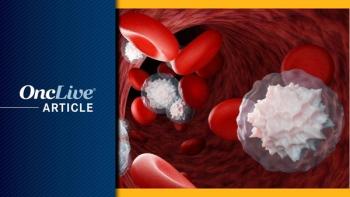
- Vol. 22/No. 09
- Volume 22
- Issue 09
Trilaciclib Tackles Myelosuppression in SCLC
Lowell L. Hart, MD, discusses trilaciclib’s unique role in patients with ES-SCLC who experience myelosuppression, as well as the future role of the agent.
Trilaciclib (Cosela) has emerged as a new supportive treatment option for reducing the frequency of myelosuppression in patients with adults with extensive-stage small cell lung cancer (ES-SCLC) receiving certain types of chemotherapy.1
The FDA approved the CDK4/6 inhibitor on February 12, 2021, based on results of 3 phase 2 studies: G1T28-05 (NCT03041311), G1T28-02 (NCT02499770), and G1T28-03 (NCT02514447).1
In G1T28-05, investigators examined 107 patients with newly diagnosed ES-SCLC not previously treated with chemotherapy. Patients were randomized to receive either trilaciclib or placebo prior to treatment with etoposide, carboplatin, and atezolizumab (Tecentriq). Results from the trial showed that of 54 patients treated with trilaciclib, 1.9% had severe neutropenia compared with 49.1% of patients in the placebo arm (n = 53).2
G1T28-02 was a randomized, double-blind examination of trilaciclib vs placebo administered to participants prior to treatment with etoposide and carboplatin. The trial included 77 patients with newly diagnosed ES-SCLC not previously treated with chemotherapy. Data showed that 5.1% of patients in the trilaciclib arm (n = 39) had severe neutropenia vs 42.1% of patients treated with placebo (n = 38).2
In the randomized, double-blind G1T28-03 trial, investigators evaluated trilaciclib vs placebo administered prior to treatment with topotecan in 61 patients with ES-SCLC who were previously treated with chemotherapy. Results showed that 40.6% of patients in the trilaciclib arm (n = 32) had severe neutropenia compared with 75.9% of patients in the placebo group (n = 29).2
In an interview with OncologyLive®, Lowell L. Hart, MD, scientific director of clinical research at Florida Cancer Specialists & Research Institute in Fort Myers, discussed trilaciclib’s unique role in patients with ES-SCLC who experience myelosuppression, as well as the future role of the agent.
What was noteworthy about the efficacy data that led to the approval of trilaciclib?
Standard treatment for ES-SCLC for a long time has been to use a platinum agent with an etoposide. More recently, atezolizumab or other immune checkpoint inhibitors have been used. The main issue [we’ve seen] with tolerability when using these agents is that they are all myelosuppressive and cause anemia, thrombocytopenia, and neutropenia. Trilaciclib is a CDK4/6 inhibitor, [known for treating patients with] breast cancer. The idea came about that perhaps a similar drug [that causes] an adverse effect in patients with breast cancer may be a good thing in patients who are receiving myelosuppressant chemotherapy. [Essentially, the agent would be] putting a patients’ bone marrow ‘to sleep’ transiently using a new intravenous formulation. It’s not a drug that you take for 2 weeks straight, but one [that is administered] before the start of chemotherapy, or in the cell cycle right before the chemotherapy hits. [This way we are] protecting the patient from the adverse effects of chemotherapy, which are greater on cells that are dividing vs cells that are “asleep.”
Patients with ES-SCLC have uniformly lost the retinoblastoma protein [RB], so you would not expect that a CDK inhibitor like trilaciclib would have any effect on the cancer. Rather, the agent [is meant to have an effect] on the quality of life of the patients. It’s essentially a supportive care drug, which may be a little hard for some oncologists to wrap their minds around because they’re used to these CDK drugs given with hormone therapy in breast cancer.
[Trilaciclib] did hit its study end points: the duration of severe neutropenia was greatly reduced, quality of life of patients was improved, and the need for RBC [red blood cell] transfusions was [reduced].
How does trilaciclib achieve these outcomes?
Trilaciclib works on the hematopoietic stem cells in the bone marrow by reducing their rate of proliferation, basically trying to [cause this effect] in the G0 phase and out of cell cycle. These cells are very vulnerable to the effects of chemotherapy. We want the chemotherapy to kill off the fast-growing cancer cells and we know, because these patients don’t have RB, they are not going to be affected by this at all. We want the chemotherapy not to affect the bone marrow cells that are equally rapidly turning over, especially neutrophils. By throwing these precursors out of cell cycle, they won’t be adversely affected by chemotherapy.
How does this approval advance the ES-SCLC treatment paradigm?
It’s very helpful. Again, the drug is not going to take a patient who is potentially incurable and make them curable. There’s a lot more focus lately on the patient’s quality of life. If we can preserve these patients’ quality of life—it will eventually deteriorate as their disease progresses—we’re really doing something beneficial for the patient. I believe it’s important for oncologists to not only focus on [whether] the cancer is 20% bigger or 20% smaller, but also on how the patient is doing, if their quality of life is being maintained. Are they not ending up having to sit around their house for 3, 4, or 5 days because they have severe neutropenia? With the use of trilaciclib, oncologists will be more comfortable using a standard dose of topotecan rather than the ad-hoc changes in doses that many of us have done [because of myelosuppressive effects].
What are the next steps for trilaciclib?
The drug’s efficacy in limited-stage disease is an area of interest. It also has had some interesting data in patients with triple-negative breast cancer [TNBC]. This is another disease where you must use chemotherapy and, similar to ES-SCLC, many of these patients have lost RB function. I participated in a study using chemotherapy with and without trilaciclib in TNBC; we saw in the data that it seemed to show some extra effects, perhaps even a little survival benefit. There are some effects that are not totally worked out to the final state yet concerning [how] this drug may [affect] the immune microenvironment. I’m looking forward to continuing to work with the drug in various other settings, seeing what effect it may have on the immune microenvironment, and seeing what other effects it has besides myelopreservation. I think the potential for other uses is out there.
References
- FDA approves drug to reduce bone marrow suppression caused by chemotherapy. FDA. February 12, 2021. Accessed April 19, 2021. https://bit.ly/3dHKllZ
- Cosela. Prescribing information. G1 Therapeutics, Inc; 2021. Accessed April 19, 2021. https:// bit.ly/3gwnThJ
Articles in this issue
over 4 years ago
Strategies for Targeting PI3K Proliferateover 4 years ago
Tivozanib Boosts RCC Treatment Portfolioover 4 years ago
Clinical Trial Diversity Efforts Gain Steamover 4 years ago
COVID-19 Has Diverse Effects on Cancer Care
























































































